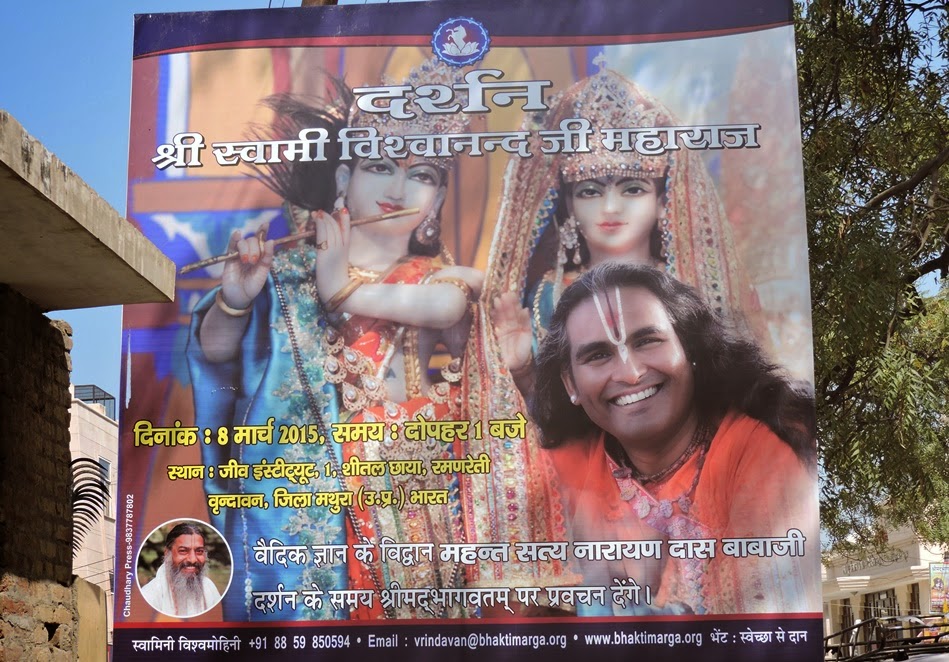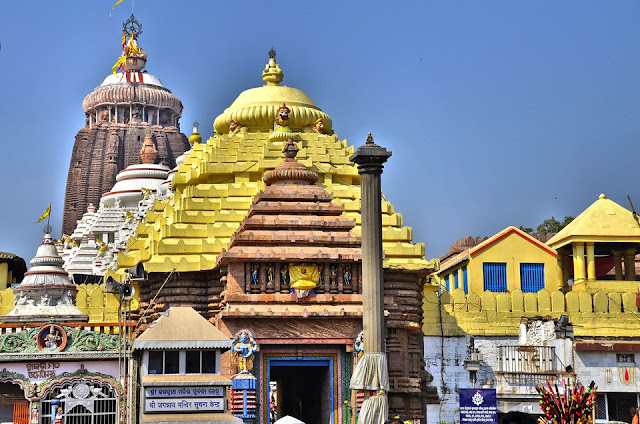The schema of three cultures
Some notes that I jotted down in the bus after completing the last post. First, the schema of three cultures.
In Western society, a romantic version of human love has become the dominant ideal expression of the affects. The hippie philosophy of love was a colossal failure, precisely because, even as the chivalrous romantics knew, human love requires spiritual refinement. The love of those who are not virtuous is often a sick, sorrowful thing. Just as sex has manifestations in the three modes of nature, so too does love.
Even so, the original romantic vision is that one is made virtuous by love. In the context of bhakti, this is also how the Vaishnavas see things: No separate culture of the will or of reason is necessary in the culture of love; the results of these other cultures, namely virtue and wisdom, are produced as byproducts of love.
But when piety is misdirected into sense gratification and its cohorts of profit, adoration, and prestige, it does not produce real virtue or wisdom, but only their facsmile. That is known as hypocrisy.
Dharma (duty or law) is the essence of karma. However, duty exists in wisdom and it also exists in love. The reason that raganuga is highly thought of, and the reason that it is a truer manifestation of bhakti, is that it is based neither in reason (yukti), nor in the will (zAstra).
====================
Edwin Bryant, in his conclusion to the compilation The Hare Krishna Movement, states that Prabhupada’s biggest error was in trying to establish the Varnashram system. I would like to refine that judgment and say that his fundamental insight—namely that the Krishna consciousness movement needed a more coherent and broader based social framework--was correct, but that it was an error to think that such a framework could be borrowed wholesale from the idealized Indian system. Indeed, the possibility exists to find a way of fitting into the very world we live in without Amish-like farm communities, but certain adjustments have to be made.
I keep coming back to the beginnings of my third stage of Krishna consciousness (the first being Iskcon, the second being a traditional “raganuga” Vaishnava, the third being my taking an intellectual distance from the tradition altogether, a stage which I am nearing the end of). When I left India, I took up householder life, but I made a huge mistake in not importing into it any of the external manifestations, i.e. rituals, of bhakti. I think that this was likely due to my all-or-nothing background and training.
I had a sense that I was to “return to the world,” but I did not really know what I was doing. I greatly underestimated the importance of ritual in even the most microcosmic level of society, which is the human couple, and then in the family.
Hinduism, of which Vaishnavism is a branch, seems to persistently negate the family, which is rather strange considering the deep and persistent networks of extended family and jati in India. Perhaps all these warnings against attachment and so on are a necessary antidote to the excesses that family attachments can create, especially in the absence of a transcendental Pole Star by which to steer. Human beings simply do not exist in a vacuum in even the best situation. We are not free-floating monads, but atoms meant to be formed into molecules. The Hindu system seems to state (in the way of the Jains) that true individuation, true liberation, can only had in isolation.
When I say that Krishna consciousness must have a worldly understanding, I am arguing pragmatically: There must be a practical message in Krishna consciousness for human survival. When I speak of human survival, I am talking in the basest, most fundamental sense. This is not always overlooked--for instance, we often heard Iskcon devotees argue that they saved the hippies from destructive drug habits, etc.--but in general, it is not something that is thought about scientifically. I was pleased to hear Joseph O’Connell's argument that Gaudiya Vaishnavism served a pragmatic social functions in post-Chaitanya Bengal by smoothing Hindu-Muslim and intercaste relations through the teaching of humility, different attitudes to purity and caste, etc. I think he was right about this, and I think we need to try to understand the pragmatic aspects of Krishna consciousness in the here-and-now. In a sense, to divest it of any spiritual meaning and try to see what material (psychological and social) purpose it might have.
In the 19th century an interesting religious phenomenon appeared in Yankee New England, the Shakers. The Shakers (who got their name from their ecstatic ceremonies) believed that all sexuality should be shunned absolutely. They had small but successful communities, but they expected to and did die out. A religious movement that does not have an effective system of reproduction and continuance in place dies out.
In the Krishna consciousness context, we were, much like the early Christians, in particular the Gnostics, saddled with an extreme other-worldly vision of spiritual perfection. This is perhaps a necessary step for a new religious grouping, but any religious system that does not have an affirming vision of sexuality is doomed. I am stating for all to hear that Krishna consciousness has a very highly affirming place for sexuality. Indeed, in the context of the feudal, property-based marriage system of traditional India, it had a revolutionary message. It made the radical proposition that we can trust the feelings and that spontaneous love between a man and woman can produce a higher standard of human achievement than a purely rational order based on duty relations. In India, this was subversive then, and is even subversive now. Indeed, because it is still subversive, a distorted Western concept of love and sexuality has come to take its place, with the concomitant conflation of Tantra with pornography or libertinism.
Sexuality is a sociological phenomenon. It creates real social links, not only within the context of married relations, but even in unmarried relations as well. Where formal marriage relations are based on religion alone, i.e. dharma or karma, law or virtue, however, there is an inevitable tendency to become destabilized. On the other hand, the fear of destabilization that comes from a purely individualistic and hedonistic attitude to sexuality is also justifiable. Nevertheless, a civilization that sees the telos of sexual love to be found in its disappearance can only be inherently unstable, or highly restricted in its reach.
I suppose I could further complicate this discussion by talking about means of production, etc., and steps to a certain modernization of society, but that will have to wait for another time. For the time being, I am simply trying to make the point that true sexual culture is one that combines sexuality with spirituality, that harnesses the energy of human sexual love and channels it into the search for and devotion to the Divine. This in turn generates the love that is needed for the creation and preservation of the family. But none of this can be achieved without ritual; that is a truth I have learned the hard way.
====================
What is guru? Coming back to an old topic and putting it in the context of statements I made in a previous post: The guru is he who provides the meta-narrative and one's place within it. As I said, the telos given by the guru is that of saintliness, which can be virtue-oriented, wisdom-oriented, or love-oriented. These are all visions of saintliness, and one chooses a guru according to one's faith, which is a product of one's situation within the modes of nature.

- the conative (i.e. the will) → karma → virtue
- the cognitive (i.e. the reason) → jnana → wisdom
- the affective (i.e. the emotions) → bhakti (piety) → love
In Western society, a romantic version of human love has become the dominant ideal expression of the affects. The hippie philosophy of love was a colossal failure, precisely because, even as the chivalrous romantics knew, human love requires spiritual refinement. The love of those who are not virtuous is often a sick, sorrowful thing. Just as sex has manifestations in the three modes of nature, so too does love.
Even so, the original romantic vision is that one is made virtuous by love. In the context of bhakti, this is also how the Vaishnavas see things: No separate culture of the will or of reason is necessary in the culture of love; the results of these other cultures, namely virtue and wisdom, are produced as byproducts of love.
But when piety is misdirected into sense gratification and its cohorts of profit, adoration, and prestige, it does not produce real virtue or wisdom, but only their facsmile. That is known as hypocrisy.
Dharma (duty or law) is the essence of karma. However, duty exists in wisdom and it also exists in love. The reason that raganuga is highly thought of, and the reason that it is a truer manifestation of bhakti, is that it is based neither in reason (yukti), nor in the will (zAstra).
Edwin Bryant, in his conclusion to the compilation The Hare Krishna Movement, states that Prabhupada’s biggest error was in trying to establish the Varnashram system. I would like to refine that judgment and say that his fundamental insight—namely that the Krishna consciousness movement needed a more coherent and broader based social framework--was correct, but that it was an error to think that such a framework could be borrowed wholesale from the idealized Indian system. Indeed, the possibility exists to find a way of fitting into the very world we live in without Amish-like farm communities, but certain adjustments have to be made.
I keep coming back to the beginnings of my third stage of Krishna consciousness (the first being Iskcon, the second being a traditional “raganuga” Vaishnava, the third being my taking an intellectual distance from the tradition altogether, a stage which I am nearing the end of). When I left India, I took up householder life, but I made a huge mistake in not importing into it any of the external manifestations, i.e. rituals, of bhakti. I think that this was likely due to my all-or-nothing background and training.
I had a sense that I was to “return to the world,” but I did not really know what I was doing. I greatly underestimated the importance of ritual in even the most microcosmic level of society, which is the human couple, and then in the family.
Hinduism, of which Vaishnavism is a branch, seems to persistently negate the family, which is rather strange considering the deep and persistent networks of extended family and jati in India. Perhaps all these warnings against attachment and so on are a necessary antidote to the excesses that family attachments can create, especially in the absence of a transcendental Pole Star by which to steer. Human beings simply do not exist in a vacuum in even the best situation. We are not free-floating monads, but atoms meant to be formed into molecules. The Hindu system seems to state (in the way of the Jains) that true individuation, true liberation, can only had in isolation.
When I say that Krishna consciousness must have a worldly understanding, I am arguing pragmatically: There must be a practical message in Krishna consciousness for human survival. When I speak of human survival, I am talking in the basest, most fundamental sense. This is not always overlooked--for instance, we often heard Iskcon devotees argue that they saved the hippies from destructive drug habits, etc.--but in general, it is not something that is thought about scientifically. I was pleased to hear Joseph O’Connell's argument that Gaudiya Vaishnavism served a pragmatic social functions in post-Chaitanya Bengal by smoothing Hindu-Muslim and intercaste relations through the teaching of humility, different attitudes to purity and caste, etc. I think he was right about this, and I think we need to try to understand the pragmatic aspects of Krishna consciousness in the here-and-now. In a sense, to divest it of any spiritual meaning and try to see what material (psychological and social) purpose it might have.
In the 19th century an interesting religious phenomenon appeared in Yankee New England, the Shakers. The Shakers (who got their name from their ecstatic ceremonies) believed that all sexuality should be shunned absolutely. They had small but successful communities, but they expected to and did die out. A religious movement that does not have an effective system of reproduction and continuance in place dies out.
In the Krishna consciousness context, we were, much like the early Christians, in particular the Gnostics, saddled with an extreme other-worldly vision of spiritual perfection. This is perhaps a necessary step for a new religious grouping, but any religious system that does not have an affirming vision of sexuality is doomed. I am stating for all to hear that Krishna consciousness has a very highly affirming place for sexuality. Indeed, in the context of the feudal, property-based marriage system of traditional India, it had a revolutionary message. It made the radical proposition that we can trust the feelings and that spontaneous love between a man and woman can produce a higher standard of human achievement than a purely rational order based on duty relations. In India, this was subversive then, and is even subversive now. Indeed, because it is still subversive, a distorted Western concept of love and sexuality has come to take its place, with the concomitant conflation of Tantra with pornography or libertinism.
Sexuality is a sociological phenomenon. It creates real social links, not only within the context of married relations, but even in unmarried relations as well. Where formal marriage relations are based on religion alone, i.e. dharma or karma, law or virtue, however, there is an inevitable tendency to become destabilized. On the other hand, the fear of destabilization that comes from a purely individualistic and hedonistic attitude to sexuality is also justifiable. Nevertheless, a civilization that sees the telos of sexual love to be found in its disappearance can only be inherently unstable, or highly restricted in its reach.
I suppose I could further complicate this discussion by talking about means of production, etc., and steps to a certain modernization of society, but that will have to wait for another time. For the time being, I am simply trying to make the point that true sexual culture is one that combines sexuality with spirituality, that harnesses the energy of human sexual love and channels it into the search for and devotion to the Divine. This in turn generates the love that is needed for the creation and preservation of the family. But none of this can be achieved without ritual; that is a truth I have learned the hard way.
What is guru? Coming back to an old topic and putting it in the context of statements I made in a previous post: The guru is he who provides the meta-narrative and one's place within it. As I said, the telos given by the guru is that of saintliness, which can be virtue-oriented, wisdom-oriented, or love-oriented. These are all visions of saintliness, and one chooses a guru according to one's faith, which is a product of one's situation within the modes of nature.




Comments